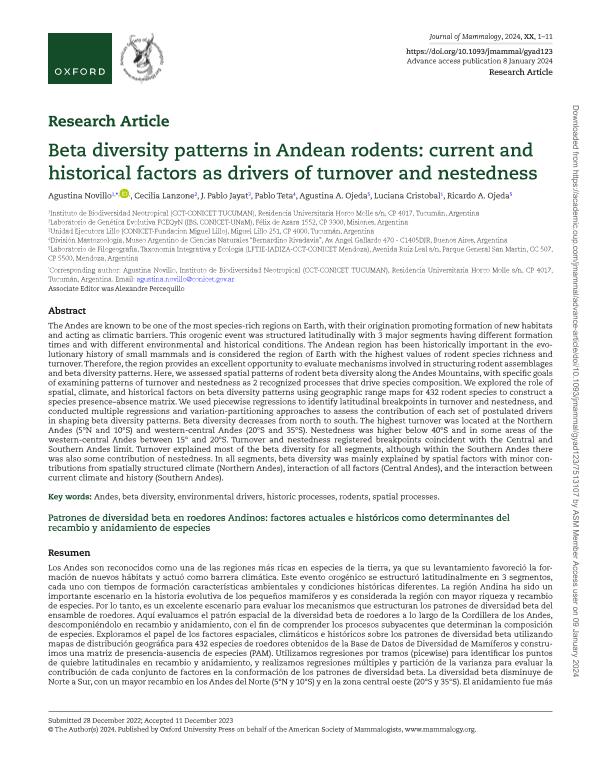Artículo
Beta diversity patterns in Andean rodents: current and historical factors as drivers of turnover and nestedness
Novillo, Agustina ; Lanzone, Cecilia
; Lanzone, Cecilia ; Jayat, Jorge Pablo
; Jayat, Jorge Pablo ; Teta, Pablo Vicente
; Teta, Pablo Vicente ; Ojeda, Agustina Alejandra
; Ojeda, Agustina Alejandra ; Cristobal, Luciana María
; Cristobal, Luciana María ; Ojeda, Ricardo Alberto
; Ojeda, Ricardo Alberto
 ; Lanzone, Cecilia
; Lanzone, Cecilia ; Jayat, Jorge Pablo
; Jayat, Jorge Pablo ; Teta, Pablo Vicente
; Teta, Pablo Vicente ; Ojeda, Agustina Alejandra
; Ojeda, Agustina Alejandra ; Cristobal, Luciana María
; Cristobal, Luciana María ; Ojeda, Ricardo Alberto
; Ojeda, Ricardo Alberto
Fecha de publicación:
01/2024
Editorial:
Oxford University Press
Revista:
Journal of Mammalogy
ISSN:
0022-2372
Idioma:
Inglés
Tipo de recurso:
Artículo publicado
Clasificación temática:
Resumen
The Andes are known to be one of the most species-rich regions on Earth, with their origination promoting formation of new habitats and acting as climatic barriers. This orogenic event was structured latitudinally with 3 major segments having different formation times and with different environmental and historical conditions. The Andean region has been historically important in the evolutionary history of small mammals and is considered the region of Earth with the highest values of rodent species richness and turnover. Therefore, the region provides an excellent opportunity to evaluate mechanisms involved in structuring rodent assemblages and beta diversity patterns. Here, we assessed spatial patterns of rodent beta diversity along the Andes Mountains, with specific goals of examining patterns of turnover and nestedness as 2 recognized processes that drive species composition. We explored the role of spatial, climate, and historical factors on beta diversity patterns using geographic range maps for 432 rodent species to construct a species presence–absence matrix. We used piecewise regressions to identify latitudinal breakpoints in turnover and nestedness, and conducted multiple regressions and variation-partitioning approaches to assess the contribution of each set of postulated drivers in shaping beta diversity patterns. Beta diversity decreases from north to south. The highest turnover was located at the Northern Andes (5°N and 10°S) and western-central Andes (20°S and 35°S). Nestedness was higher below 40°S and in some areas of the western-central Andes between 15° and 20°S. Turnover and nestedness registered breakpoints coincident with the Central and Southern Andes limit. Turnover explained most of the beta diversity for all segments, although within the Southern Andes there was also some contribution of nestedness. In all segments, beta diversity was mainly explained by spatial factors with minor contributions from spatially structured climate (Northern Andes), interaction of all factors (Central Andes), and the interaction between current climate and history (Southern Andes).
Archivos asociados
Licencia
Identificadores
Colecciones
Articulos(IADIZA)
Articulos de INST. ARG DE INVEST. DE LAS ZONAS ARIDAS
Articulos de INST. ARG DE INVEST. DE LAS ZONAS ARIDAS
Articulos(IBN)
Articulos de INSTITUTO DE BIODIVERSIDAD NEOTROPICAL
Articulos de INSTITUTO DE BIODIVERSIDAD NEOTROPICAL
Articulos(IBS)
Articulos de INSTITUTO DE BIOLOGIA SUBTROPICAL
Articulos de INSTITUTO DE BIOLOGIA SUBTROPICAL
Articulos(UEL)
Articulos de UNIDAD EJECUTORA LILLO
Articulos de UNIDAD EJECUTORA LILLO
Citación
Novillo, Agustina; Lanzone, Cecilia; Jayat, Jorge Pablo; Teta, Pablo Vicente; Ojeda, Agustina Alejandra; et al.; Beta diversity patterns in Andean rodents: current and historical factors as drivers of turnover and nestedness; Oxford University Press; Journal of Mammalogy; 105; 2; 1-2024; 230-240
Compartir
Altmétricas



